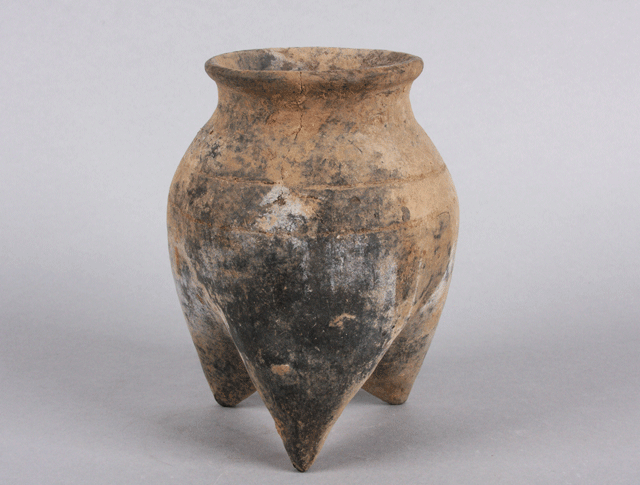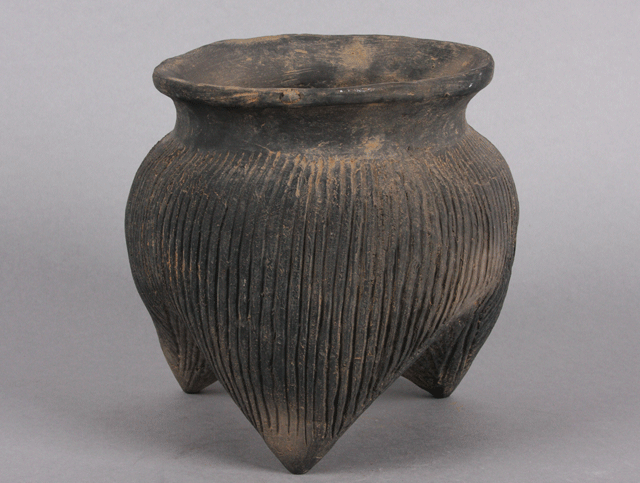
2012.91.10, Li (鬲; tripod jar); Zhukaigou culture (2000–1400 B.C.)
Eason Eige Collection; photo by B. Bernard

2012.91.10, Li (鬲; tripod jar); Zhukaigou culture (2000–1400
B.C.)
Eason Eige Collection; photo by B. Bernard
Tripod vessels appear in China in the early Neolithic period (7000–5000 BCE). However the innovation of hollow legs, creating the characteristic Li (鬲) and tripods and Gui (簋) tripod pitchers does not appear until the middle Neolithic (5000–3000 BCE). The earliest examples found by archaeologists, so far, have been at Dawenkou sites in the Yellow River Valley. Many researchers ascribe great ignificance to the shape of these tripods as being suggestive of goats' or cows' udders and therefore important for ritual activity. Later finds during the bronze age confirm that the Gui (簋) were indeed part of ritual practice.
Of greater significance, however, is the technological innovation of hollow legs, which is uniquely Chinese. By the time the hollow legs were created, ceramic technology allowed for vessels that could be placed directly in a fire without fear of cracking. As evidenced by scorching and soot found on excavated examples, Li (鬲) and Gui (簋) tripods were placed directly into the fire where their contents could be heated and cooked more economically than in earlier vessels. The shape remained popular for many centuries, eventually being replicated in bronze during the Shang and Zhou dynasties. During the florescence of these Bronze Agy cultures the shape was merged with that of Ding (鼎) tripods to create a hybrid ritual object. Eventually, as metallurgy and cooking techniques advanced, the classic udder shape of the Li (鬲) and Gui (簋) ceramic vessels disappeared.
Three-legged Ding (鼎)vessels appear in China during the early to middle Neolithic period, about 9000 BCE. The classic legged vessels used for ancestor worship don't appear until 3900 BCE, in the Bronze Age Erlitou culture. From that point onward, they appear both as pottery and in bronze. By the Erlingang state (3600 BCE) the vessels have taken on the characteristics best known from examples of the Shang and Zhou dynasties.
During the Zhou dynasty (1046–256 BCE), the use of sacrificial vessels was regulated, as is minutely described in the Book of Rites. The King of Zhou, who had the mandate of heaven, was allowed to use nine Ding (鼎) and eight Gui (簋). A duke or Zhuzhou (諸侯) Gong (公) was allowed to use seven Ding and six Gui, a baron or Daifu (大夫) could use five Ding and three Gui, and a lesser nobleman was allowed to use three Ding and two Gui. The extravagant and highly detailed bronze vessels we associate with the height of the Chinese Bronze age fell out of usage by the Han dynasty, but Ding (鼎) were still made and used for ritual.
The tripod vessel shown at the top of this page measures 6 1/2 inches (16 cm)
tall and was made in Inner Mongolia, by a culture that shifted from hunting
and gathering to farming and then increasingly to pastorlism.
By clicking on the photos that follow, you will reach new pages with
additional examples of Chinese tripod vessels, from various periods and cultures.

Li (鬲), Shang dynasty (Bronze Age)
See source code for copyright information. Page last revised on June 15, 2015. Please report problems to toh@unm.edu